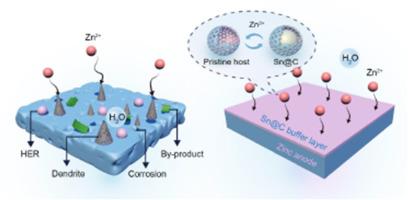Interfacial space confinement engineering toward ultrastable all-climate aqueous zinc ion batteries
IF 18.9
1区 材料科学
Q1 CHEMISTRY, PHYSICAL
引用次数: 0
Abstract
The interfacial instability, particularly uncontrollable Zn nucleation and deposition, significantly impeding the commercialization of aqueous zinc ion batteries (ZIBs). Herein, we propose an interfacial space confinement strategy to enable the dendrite-free anode, specifically through constructing a zincophilic buffer layer based on hollow Sn@C. The porous Sn@C contributes to modify the electrical double layer structure, which greatly alleviates the concentration polarization during high-rate plating. In-situ experimental results demonstrate the inhibited H2O-mediated parasitic side reactions and the absence of dendrite deposition morphology. Based on the improved thermodynamics and kinetics, zincophilic buffer layers can deliver low nucleation overpotential (20 mV), ultrastable cycle life (> 5000 h), and excellent zinc utilization rate (62.4%). Importantly, the full batteries with zincophilic buffer layer exhibit excellent electrochemical stability over -40 to 70 °C, pushing forward the construction of advanced all-climate ZIBs.


面向超稳定全气候锌离子水电池的界面空间约束工程
界面的不稳定性,尤其是无法控制的锌成核和沉积,严重阻碍了水性锌离子电池(ZIB)的商业化。在此,我们提出了一种界面空间限制策略,特别是通过构建基于中空Sn@C的亲锌缓冲层来实现无枝晶阳极。多孔的 Sn@C 有助于改变电双层结构,从而大大缓解了高速率电镀过程中的浓度极化问题。原位实验结果表明,由 H2O 介导的寄生副反应受到抑制,且无树枝状沉积形态。基于改进的热力学和动力学,亲锌缓冲层可以提供低成核过电位(20 mV)、超稳定循环寿命(5000 小时)和出色的锌利用率(62.4%)。重要的是,带有亲锌缓冲层的全电池在 -40 至 70°C 温度范围内表现出卓越的电化学稳定性,推动了先进的全气候 ZIB 的构建。
本文章由计算机程序翻译,如有差异,请以英文原文为准。
求助全文
约1分钟内获得全文
求助全文
来源期刊

Energy Storage Materials
Materials Science-General Materials Science
CiteScore
33.00
自引率
5.90%
发文量
652
审稿时长
27 days
期刊介绍:
Energy Storage Materials is a global interdisciplinary journal dedicated to sharing scientific and technological advancements in materials and devices for advanced energy storage and related energy conversion, such as in metal-O2 batteries. The journal features comprehensive research articles, including full papers and short communications, as well as authoritative feature articles and reviews by leading experts in the field.
Energy Storage Materials covers a wide range of topics, including the synthesis, fabrication, structure, properties, performance, and technological applications of energy storage materials. Additionally, the journal explores strategies, policies, and developments in the field of energy storage materials and devices for sustainable energy.
Published papers are selected based on their scientific and technological significance, their ability to provide valuable new knowledge, and their relevance to the international research community.
 求助内容:
求助内容: 应助结果提醒方式:
应助结果提醒方式:


